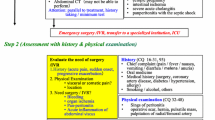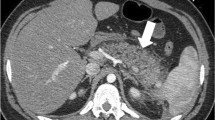Abstract
Aim-Background
Patients who have sustained blunt abdominal trauma (BAT) pose a diagnostic challenge. Intraabdominal injuries may lead to increased morbidity and mortality. Abdominal computed tomography (CT) is the gold standard for identifying abdominal injuries, but is associated with radiation exposure and longer emergency hospital stay and increased health care costs. The aim of this study was to correlate the initial abdominal ultrasound (U/S) imaging findings with CT findings and clinical outcome in patients with BAT.
Methods
The study population consisted of 61 adult trauma patients. The inclusion criteria were suspected BAT, hemodynamic stability and a score on the Glasgow coma scale (GCS) of ≥14. Patients requiring immediate surgical intervention were excluded.
Results
Of the 61 patients in the study, 18 (29.6%) were female and 43 (70.4%) were male, with a mean age of 54.8 years and 39.6 years, respectively. The mechanism of injury included: motor vehicle collision 16 (26.2%), motorcycle related 23 (37.7%), falls 18 (29.5%), pedestrian road traffic accident 3 (4.9%), and one (1.6%) assault. All the patients were hemodynamically stable, had a GCS ≥14 and had a suspicion of BAT. All the study patients underwent abdominal CT and U/S. The focused assessment with sonography (FAST) was negative for free fluid in 23 patients, in 9 of which minor visceral injuries were revealed on CT, but none needed surgical intervention. In 28 patients, free fluid or parenchymal injury was detected on abdominal U/S, which was confirmed on CT in 22 patients. In this group, 6/28 patients required surgical intervention due to clinical deterioration. Finally, when both fluid and parenchymal organ injuries were detected on U/S, the CT scan was positive in every case (10/10), but only 2 of these patients required surgical intervention. All of the study patients made a good recovery.
Conclusion
Patients with BAT that meet certain clinical criteria and have a negative complete abdominal U/S imaging can be safely managed and discharged without the need for a CT scan.
Similar content being viewed by others
References
Nishijima DK, Simel DL, Wisner DH, et al. Does This adult patient have a blunt intra-abdominal injury? JAMA. 2012;307:1517–27.
Brown CK, Dunn KA, Wilson K. Diagnostic evaluation of patients with blunt abdominal trauma: A decision analysis. Acad Emerg Med 2000;7:385–96.
Fakhry SM, Brownstein M, Watts DD, et al. Relatively short diagnostic delays (<8 Hours) Produce morbidity and mortality in blunt small bowel injury: An analysis of time to operative intervention in 198 patients from a multicenter experience. J Trauma, 2000;48:408–15.
Jansen JO, Yule SR, Loudon MA. Investigation of blunt abdominal trauma. BMJ 2008;336(7650):938–42.
Hoff WS, Holevar M, Nagy KK, et al. Eastern asociation for the surgery of trauma. Practice management guidelines for the evaluation of blunt abdominal trauma: The EAST Practice Management Guidelines Work Group, J Trauma, 2002;53:602–15.
Linsenmaier U, Krötz M, Häuser H, et al. Whole-body computed tomography in polytrauma: Techniques and management. Eur Radiol 2002;12:1728–40.
Jhirad R, Boone D. Computed tomography for evaluating blunt abdominal trauma in the low-volume nondesignated trauma center: The procedure of choice? J Trauma 1998;45:64–8.
Stanescu AL, Gross J.A, Bittle M, et al. Imaging of blunt abdominal trauma. Semin. Roentgen 2006;41:196–204.
Gardner RL, Sarkar U, Maselli JH, et al. Factors associated with longer EDlengths of stay. Am J Emerg Med 2007;25:643–50.
Smith-Bindman R1, Lipson J, Marcus R, et al. Radiation dose associated with common computed tomography examinations and the associated lifetime attributable risk of cancer. Arch Intern Med 2009;169:2078–86.
Lee WS, Parks NA, Garcia A, et al. Pan computed tomography versus selective computed tomography in stable, young adults after blunt trauma with moderate mechanism: A cost-utility analysis. J Trauma Acute Care Surg 2014;77:527–33.
Holmes JF, Wisner DH, McGahan JP, et al. Clinical prediction rules for identifying adults at very low risk for intra-abdominal injuries after blunt trauma. Ann Emerg Med 2009;54:575–84.
Mofidi M, Hasani A, Kianmehr N. Determining the accuracy of base deficit in diagnosis of intra-abdominal injury in patients with blunt abdominal trauma. Am J Emerg Med 2010;28:933–6.
Poletti PA, Mirvis SE, Shanmuganathan K, et al. Blunt abdominal trauma patients: Can organ injury be excluded without performing computed tomography? J Trauma 2004;57:1072–81.
Sahdev P, Garramone RRJr, Schwartz RJ, et al. Evaluation of liver function tests in screening for intra-abdominal injuries. Ann Emerg Med 1991;20:838–41.
Stengel D, Rademacher G, Ekkernkamp A, et al. Emergency ultrasound-based algorithms for diagnosing blunt abdominal trauma. Cochrane Database Syst Rev 2015; Doi: 10.1002/14651858.CD004446.pub4.
American College of Emergency Physicians. Emergency ultrasound imaging criteria compendium. American College of Emergency Physicians. Ann Emerg Med 2006;48:487–510.
Melniker LA, Leibner E, McKenney MG, et al. Randomized controlled clinical trial of point-of-care, limited ultrasonography for trauma in the emergency department: The first sonography outcomes assessment program trial. Ann Emerg Med 2006;48:227–35.
Natarajan B, Gupta PK, Cemaj S, et al. FAST scan: Is it worth doing in hemodynamically stable blunt trauma patients? Surgery. 2010;148:695–700.
Rose JS, Levitt MA, Porter J, et al. Does the presence of ultrasound really affect computed tomographic scan use? A prospective randomized trial of ultrasound in trauma. J Trauma 2001;51:545–50.
Sirlin CB, Brown MA, Andrade-Barreto OA, et al. Blunt abdominal trauma: Clinical value of negative screening US scans. Radiology 2004;230:661–8.
Deunk J, Brink M, Dekker HM, et al. Predictors for the selection of patients for abdominal CTafter blunt trauma: A proposal for a diagnostic algorithm. Ann Surg 2010;251:512–2.
Körner M, Krötz MM, Degenhart C, et al. Current Role of Emergency USin Patients with Major Trauma. Radiographics 2008;28:225–42.
Röthlin MA, Näf R, Amgwerd M, et al. Ultrasound in blunt abdominal and thoracic trauma. J Trauma 1993;34:488–95.
Sato M, Yoshii H. Reevaluation of ultrasonography for solidorgan injury in blunt abdominal trauma. J Ultrasound Med 2004;23:1583–96.
Bode PJ, Edwards MJ, Kruit MC, et al. Sonography in a clinical algorithm for early evaluation of 1671 patients with blunt abdominal trauma. AJR Am J Roentgenol 1999;172:905–11.
Marco GG1, Diego S, Giulio A, et al. Screening US and CT for blunt abdominal trauma: A retrospective study Eur J Radiol 2005;56:97–101.
Dehqanzada ZA, Meisinger Q, Doucet J, et al. Complete ultrasonography of trauma in screening blunt abdominal trauma patients is equivalent to computed tomographic scanning while reducing radiation exposure and cost. J Trauma Acute Care Surg 2015;79:199–205.
Blackbourne LH, Soffer D, McKenney M, et al. Secondary ultrasound examination increases the sensitivity of the FAST exam in blunt trauma. J Trauma 2004;57:934–8.
Dammers D, El Moumni M, Hoogland I.I, et al. Should we perform a FAST exam in haemodynamically stable patients presenting after blunt abdominal injury: A retrospective cohort study. Scand J Trauma Resusc Emerg Med 2017;25:1.
Chardoli M, Rezvani S, Mansouri P, et al. Is it safe to discharge blunt abdominal trauma patients with normal initial findings? Acta Chir Belg 2017;117:211–5.
Barbier L, Calmels M, Lagadec M, et al. Can we refine the management of blunt liver trauma? J Visc Surg 2018.
Moura FHB, Parreira JG, Mattos T, et al. Ruling out intraabdominal injuries in blunt trauma patients using clinical criteria and abdominal ultrasound. Rev Col Bras Cir 2017 Nov-Dec;44:626–32.
Author information
Authors and Affiliations
Corresponding author
Rights and permissions
About this article
Cite this article
Tsiftsis, D., El-Fellah, N., Xatzivasilliou, A. et al. The Value of Complete Ultrasonography Diagnosis in the Management of Selected Patients with Abdominal Trauma. Hellenic J Surg 90, 115–120 (2018). https://doi.org/10.1007/s13126-018-0455-1
Received:
Accepted:
Published:
Issue Date:
DOI: https://doi.org/10.1007/s13126-018-0455-1




